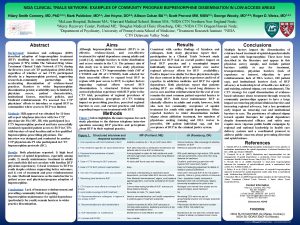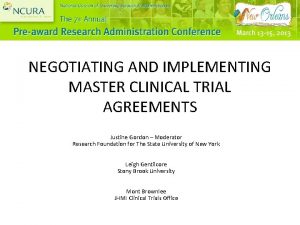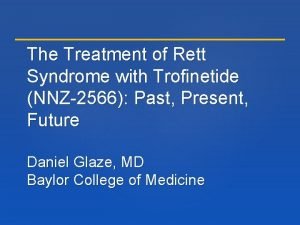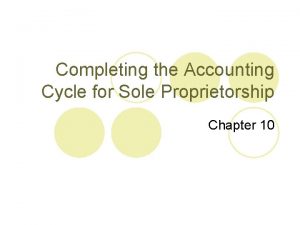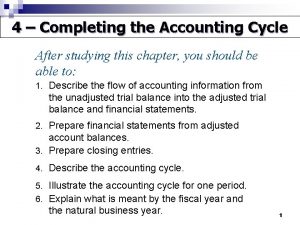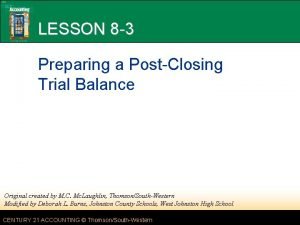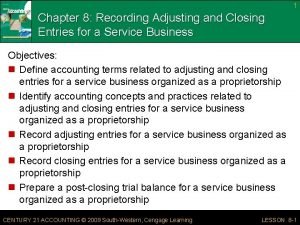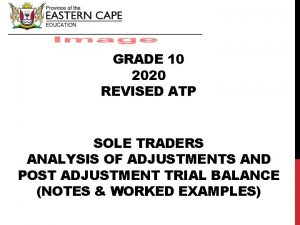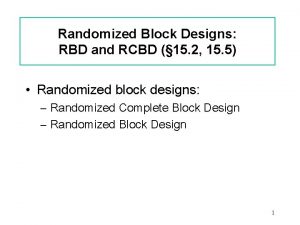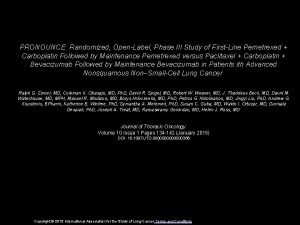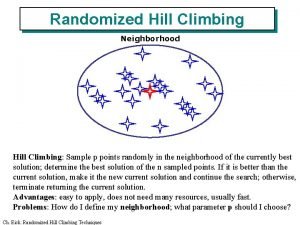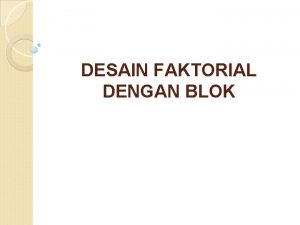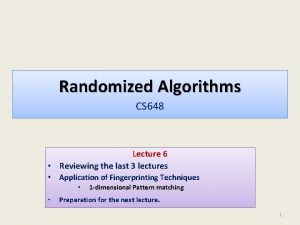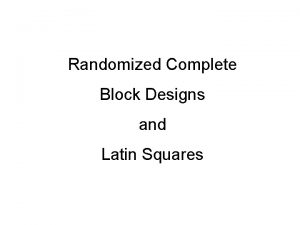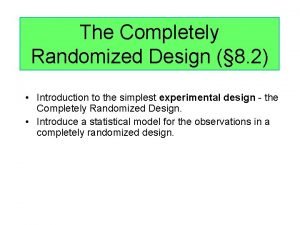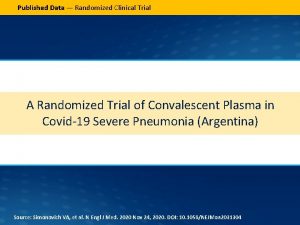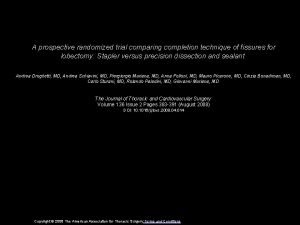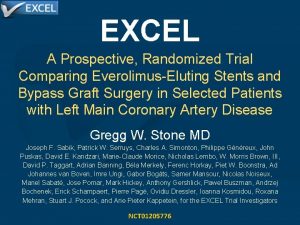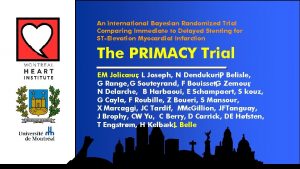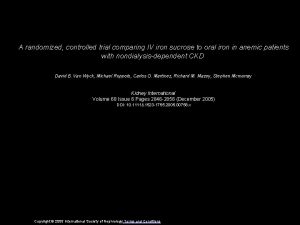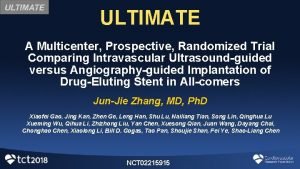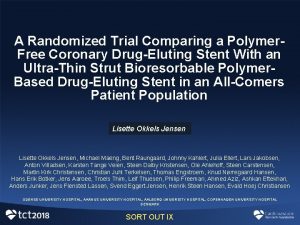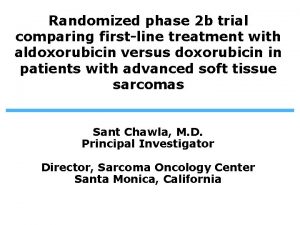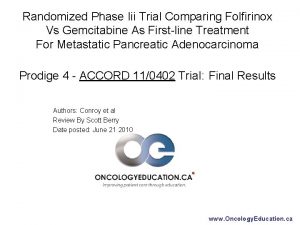Randomized Clinical Trial Comparing the Effects of Post







































- Slides: 39

Randomized Clinical Trial Comparing the Effects of Post Placement on Failure Rate of Postendodontic Restorations: Preliminary Results of a Mean Period of 32 Months Kerstin Bitter, DDS, *, § Jo¨rn Noetzel, DDS, *, § Oliver Stamm, DDS, * Juliane Vaudt, DDS, * Hendrik Meyer-Lueckel, DDS, Ph. D, † Konrad Neumann, Ph. D, ‡ and Andrej M. Kielbassa, DDS, Ph. D*

Introduction • Restoration of endodontically treated teeth with fiber reinforced composite (FRC) posts has been proposed as a viable alternative to metal posts • Clinical studies demonstrated heterogeneous failure rates of up to 32. 5% after 5 years (8) for FRC posts.

Introduction • The effect of post placement on the fracture resistance of endodontically treated teeth in vitro has been discussed controversially. • a significant effect of the amount of residual tooth structure on the fracture resistance, post placement did not significantly affect the fracture load • post placement revealed a significant effect on the fracture resistance of endodontically teeth. • results might be attributed to the different tooth types investigated in the studies.

Introduction • The aim of the present study was to investigate the time to failure of endodontically treated anterior and posterior teeth restored with a single-unit final restoration with and without posts. • For this purpose teeth were divided into 3 different groups according to the coronal substance loss and restored either with or without post retention. • The final coronal restoration was chosen as indicated by the clinical situation and the coronal substance loss.

Introduction • margin of equivalence of 15% (ie, the working hypothesis was that the post has no relevant influence on failure( • the null hypothesis (H 0) was that failure rates differ more than 15% in subgroups post and subgroups no post.

Materials and Methods • Between April 2004 and May 2007, 100 patients in need of a postendodontic restoration were screened and assessed for eligibility in the Department of Operative Dentistry and Periodontology, Charite´ Universita¨tsmedizin Berlin, Germany.

Materials and Methods • The following inclusion criteria had to be met : (1) the amount of residual tooth structure had to fit into the following 3 groups 2 -walls group , 2 or more coronal walls exceeding 2 mm above the gingival level 1 -wall group , 1 coronal wall remaining that exceeds 2 mm above the gingival level no-wall group, no coronal wall exceeding 2 mm above the gingival level but preparation of a ferrule of 2 mm possible

Materials and Methods (2)symptom-free tooth with a root canal filling without periapical lesion and with a minimum apical seal of 4 mm (3)no or no untreated advanced periodontitis with a maximum pocket depth of 5 mm without bleeding on probing )4) tooth mobility no more than score 1 (5) furcation involvement no more than grade 1 (6) willingness of the patient to return to recall intervals for at least 3 years.

Materials and Methods • In subgroups no post • gutta-percha was removed from the root canals by using Gates Glidden burs to a depth of 3 mm from the canal orifice • the core build-up was performed by using Clearfil Core/New Bond (Kuraray, Osaka, Japan ( • In cases of direct composite restorations, the build-up was performed by using Tetric Ceram/Syntac Classic (Ivoclar Vivadent) according to the manufacturer’s recommendations.

Materials and Methods • In subgroups post • DT Light Post (VDW) was placed with a length of 7– 8 mm, leaving at least an apical seal of 4 mm of the root canal filling. • Post luting and core build-up were performed by using Clearfil Core.

Materials and Methods • No more than 3 restorations per patient were included. • In each case, posts and final restorations were placed by 1 of 4 experienced operators with expertise in the field of postendodontic treatment. • Operators were calibrated before the study.

Materials and Methods • Final restorations were chosen according to the amount of the coronal substance loss to preserve as much of sound tooth structure as possible and indicated. • Direct composite restorations were indicated for teeth that exhibited a minor coronal substance loss including 2 or more remaining coronal walls. • Partial crowns were selected for large occlusal and proximal defects with intact buccal and/or oral walls that required cuspal coverage of the teeth.

Materials and Methods • Ceramic partial crowns were indicated for situations with high aesthetic demands, and if isolation with rubber dam was possible. • Full crowns were chosen for teeth with a high coronal substance loss (ie, 1 or no coronal wall remaining). Crown preparations were performed with a circumferential ferrule of at least 2 mm.

Materials and Methods • At baseline examination were recorded: age and gender of the patient, dental and periodontal status, included tooth type, radiograph of the root filling of the included tooth, post type (DT Light Post Size II or III), and final coronal restoration. • The patients were recalled at 6, 12, 24, 36, and up to 56 months. • After 12 and 36 months radiographs were taken

Materials and Methods • Primary end point was loss of the restoration for any reason. • Secondary end points were post debonding, post fracture, vertical or horizontal tooth fracture, failure of the core portion requiring a new coronal restoration, endodontic or periradicular conditions requiring endodontic retreatment, and tooth loss. • Evaluation of success or failure was performed by one examiner who was not the operator.

Materials and Methods • Statistical analyses were performed with SPSS version 16. 0 software (SPSS, Chicago, IL. ( • Kaplan-Meier plots were calculated for each subgroup. • Differences in time to failure in each group were calculated by using log-rank test. • R-package was used to calculate differences of failure rates including 95% confidence intervals • The level of significance was set at a = 0. 05.

Results • Three patients were excluded from the analyses because they did not attend any recall interval. • Eleven patients were lost to follow-up. • minimum and maximum observation periods of 6 and 56 months, 32. 4 (13. 7) months.

Results • Forty-two men and 49 women • aged 24– 80 years [50 (15) years [ • Twenty-five anterior teeth (20. 8%) and 95 posterior teeth (79. 2%) were analyzed. • Operator 1 treated 55 teeth, operator 2 seven teeth, operator 3 thirty-nine teeth, and operator 4 nineteen teeth.

Results • Final and failed restorations are described in Table 1. • The overall failure rate after 3 years was 8%. • In subgroups no post, the failure rate was 10%, whereas in subgroups post, 7% of the teeth failed. This difference was not significant. • The difference of failure rate (DFR) was 3% (Fig. 2. (

Results • In no-wall group, post placement had a significant effect on the survival rate. Teeth without post retention revealed a significantly higher failure rate (31%) compared with teeth restored with post retention (7%. ( • In 1 -wall group, no effects of post placement on the failure rate. • In 2 -walls group, no analysis could be performed because no failure occurred.

Results • In 1 -wall group, 3 failures occurred. Subgroup no post - vertical root fracture was observed. Subgroup post - loss of retention of post and core buildup in one situation - a vertical root fracture occurred, resulted in the extraction of the teeth.

Results • In no-wall group 6 failures were observed • subgroup no post, all failures (5 teeth) showed a loss of retention of the core build-up. -Two of these failures occurred in combination with a vertical root fracture, and the teeth had to be extracted. -In one situation, secondary caries led to the extraction of the tooth. • subgroup post, 1 post fractured, and the tooth could be restored after removal of the post.

Discussion • The null hypothesis of the present study was rejected because differences in failure rates between the 2 subgroups were not higher than 15%. • The survival rate of teeth restored with quartz fiber posts in the present study (92%) was similar to previously published results that showed a 3 -year survival rate of 91% for premolars restored with DT Light posts.

Discussion • the respective restoration forms were chosen according to the substance loss of the affected teeth • overtreatment for teeth exhibiting 2 or more coronal walls should be avoided. • direct composite restorations have been included in the present clinical trial too.

Discussion • preservation of sound tooth structure is regarded as the most important aspect in increasing the survival rate of endodontically treated teeth. • preparation of indirect restorations requires the removal of more sound tooth structure compared with direct restorations

Discussion • ceramic-metal crown coverage did not enhance the clinical performance of endodontically treated teeth when compared with placement of a direct composite restoration during a 3 -year period. Mannocci F, et al. J Prosthet Dent 2002 • direct fiber reinforced (class II) composite resin restorations demonstrated excellent clinical performance at 1 year in endodontically treated teeth. Deliperi S, Bardwell DN. J Adhes Dent 2009

Discussion • This has been confirmed by the present results, because we did not observe any failures with the direct composite restorations as well. • Previously, anterior teeth showed a higher failure rate compared with posterior teeth.

Discussion • In the present study design, teeth were consecutively included according to the coronal substance loss and randomly assigned to 2 intervention groups. • Tooth type was not considered during assignment. • statistical analysis concerning the effects of tooth type on failure rates would have required a much larger sample size.

Discussion • no failure occurred with teeth that demonstrated 2 or more coronal walls (2 -walls group. ( • post placement did not affect the overall failure rate and in particular the failure rates of teeth that exhibited 1 or more coronal walls. • However, a longer observation period for all included teeth is necessary.

Discussion • The margin of equivalence in the present study was set at 15%, which is a relatively high value to assume that there are no differences in failure between groups.

Discussion • Three failures occurred for post restorations in the present study • in 1 -wall group and no-wall group: 1 post fracture, 1 post debonding, and 1 vertical root fracture. • Reasons for clinical failures of fiber post restorations have been discussed controversially in the literature.

Discussion • Post debonding has been described as the most frequent unfavorable event for post-retained restorations (5, 9, 26( • whereas another study revealed post fractures as the most frequent reason for failure followed by post debonding (41% of all failures), followed by post debonding (34% of all failures) (8. (

Discussion • Differences in fatigue resistance of the various investigated post systems (33) as well as the use of different resin cements (34, 35) might have affected these results. • the limited number of failures in the present study does not allow for further conclusions.

Discussion • Failure reasons of non-posted roots in no-wall group were loss of retention of the core build-up in all cases. • In 2 of these cases vertical root fractures were observed too. • previously published data (9) speculated about a protective role of fiber posts against this most serious type of failure (ie, tooth fracture. (

Discussion • the present study showed 1 vertical root fracture for posted roots compared with 3 vertical fractures for nonposted roots. • evaluation of long-term survival data from the present population is mandatory.

Discussion • differences between operators were minimized by using standardized procedures • Bonding to intraradicular dentin is still a critical issue (35, 36) and less effective compared with coronal dentin. • the present study observed only 1 post debonding and 1 post fracture for posted roots, whereas in 5 cases loss of the core portion for non-posted roots could be revealed.

Discussion • This leads to the assumption that bonding to the pulpal floor and to the canal orifice might also be less effective. • shear stresses occurring during mastication at the adhesive interface at the pulpal floor and the canal orifices could not be compensated without post retention for teeth providing no coronal wall, even though preparation of a circumferential ferrule of 2 mm. • This has also been corroborated in vitro (20).

Conclusion • Within the limitations of the present study (inclusion of various coronal single-unit restorations, unequal distribution of the various tooth types, as well as a mean observation period of 32. 4 [13. 7] months , (

Conclusion • it can be concluded that quartz fiber post placement is efficacious to reduce failures of postendodontic restorations of teeth that exhibit no coronal wall above 2 mm of the gingival level. • Post insertion for teeth showing a minor substance loss should be critically reconsidered to avoid overuse.
 Advantage of randomized controlled trial
Advantage of randomized controlled trial Clinical trial worksheet
Clinical trial worksheet Novel clinical drug trial design
Novel clinical drug trial design Accelerated clinical trial agreement acta
Accelerated clinical trial agreement acta Nida clinical trial network
Nida clinical trial network Clinical trial iwr
Clinical trial iwr Rsna clinical trial processor
Rsna clinical trial processor Master clinical trial agreements
Master clinical trial agreements Clinical trials gov api
Clinical trials gov api Mosaico clinical trial
Mosaico clinical trial Ivd clinical trial design
Ivd clinical trial design Morpheus bms
Morpheus bms Accelerated clinical trial agreement template
Accelerated clinical trial agreement template Clinical trial matching service
Clinical trial matching service Clinical trial financial management
Clinical trial financial management Prs clinical trial
Prs clinical trial Clinical trial exports
Clinical trial exports Clinical trial budget example
Clinical trial budget example Trofinetide
Trofinetide Clinical trial timeline
Clinical trial timeline Clinical trial centers alliance
Clinical trial centers alliance Fsfd clinical trial
Fsfd clinical trial Closing entries sole proprietorship
Closing entries sole proprietorship Post closing trial balance for merchandising business
Post closing trial balance for merchandising business Completing the accounting cycle
Completing the accounting cycle Post closing trial balance definition
Post closing trial balance definition Post-closing trial balance
Post-closing trial balance Accounting atp
Accounting atp Layout of rbd
Layout of rbd Nivolumab pronounce
Nivolumab pronounce Randomized hill climbing
Randomized hill climbing Randomized polynomial time
Randomized polynomial time R o x o research design
R o x o research design Randomized hill climbing
Randomized hill climbing Factorial randomized block design
Factorial randomized block design Types of randomized algorithms
Types of randomized algorithms Randomized algorithm in daa
Randomized algorithm in daa Randomized block design
Randomized block design Randomized block design
Randomized block design Completely randomized design
Completely randomized design




